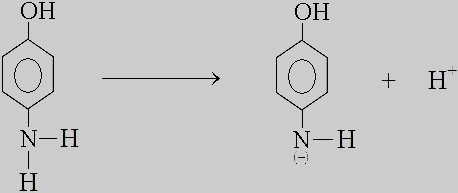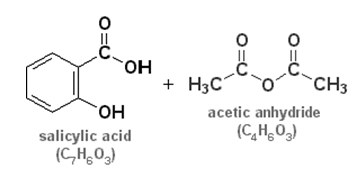Laboratory Manual
Course: 310
Subject: Practical - Medicinal Chemistry

Course: 310
Subject: Practical - Medicinal Chemistry
Prepared By
Md. Imran Nur Manik
M.Pharm
Departmnt of Pharmacy
Uniersity of Rajshahi
Md. Imran Nur Manik
M.Pharm
Departmnt of Pharmacy
Uniersity of Rajshahi
Rajshahi-6205, Bangladesh
Available at
Essential Pharma documents
www.pharmacydocs.blogspot.com
Essential Pharma documents
www.pharmacydocs.blogspot.com
INDEX
Serial No.
|
Date
|
Name of the experiment
|
Page No.
|
01
|
Synthesis of Paracetamol.
|
02 –0 5
| |
02
|
Synthesis of acetanilide.
|
06 –0 9
| |
03
|
Synthesis of Esters.
|
10 – 12
| |
04
|
Synthesis of Aspirin
|
13 – 16
|
Experiment Number: 01
|
Date:18.09.2012
|
Name of The Experiment: Synthesis of Paracetamol
| |
Principle:
Paracetamol or acetaminophen is an analgesic & antipyretic drug that may be conveniently prepared in the laboratory from Para-Aminophenol. Para-Aminophenol is readily acetylated with acetic anhydride to give paracetamol, or 4-Hydroxy acetanilide, or Parahydroxy acetanilide or para acetyl aminophenol, or para aceaminidophenol, or para acetaminophenol, or N acetyl para aminophenol.
Paracetamol or acetaminophen is an analgesic & antipyretic drug that may be conveniently prepared in the laboratory from Para-Aminophenol. Para-Aminophenol is readily acetylated with acetic anhydride to give paracetamol, or 4-Hydroxy acetanilide, or Parahydroxy acetanilide or para acetyl aminophenol, or para aceaminidophenol, or para acetaminophenol, or N acetyl para aminophenol.
Reaction: 
Mechanism of reaction:
The amino group (NH2) is more readily acetylated than the phenolic hydroxyl (OH) group.
The following steps are involved in the formation of paracetamol.
The following steps are involved in the formation of paracetamol.
Step 1: First step involves the formation of Acetylium ion, the reaction is enhanced by proton donation by concentrated acid.

Step 2: Amino group of Para-Aminophenol dissociates as follows:
Step 3: Acetylium ion attacks the anion at the nitrogen atom to form Para-acetyl Aminophenol or Paracetamol.
Reagents:
- Para-aminophenol 4. Concentrated H2SO4
- Acetic anhydride 5. Distilled water
- Alcohol
Apparatus:
- Beaker 5. Funnel
- Filter paper 6. Stirrer
- Water bath 7. Glass tube
- Measuring cylinder 8. Vacuum pump
Procedure:
1. 5.5 gm of Para-Aminophenol and 15 ml of distilled water were taken in a 250 ml conical flask.
2. 7 ml of acetic anhydride and 2 drops of concentrated H2SO4 was added to it and was stirred .The reaction mixture was stirred and then it was warmed on a were bath for about 10 minutes at the temperature of 40-60°C. The volume of reaction mixture was decreased by heating it on the water bath.
3. After 10 minutes when solid was dissolved, it was then cooled in refrigerator for about 10 minutes, until the crystal’s ware appeared and vacuum filtered. The solid portion s was acetyl derivatives.
4. It was then recrystallized from 75 ml of hot water and 10 ml of alcohol. Warmed for 3 minutes and cooled in the refrigerator for 10 minutes until crystal was appeared. Then the crystal was filtered by vacuum pump and was dried.
4. It was then recrystallized from 75 ml of hot water and 10 ml of alcohol. Warmed for 3 minutes and cooled in the refrigerator for 10 minutes until crystal was appeared. Then the crystal was filtered by vacuum pump and was dried.
Calculation:
Molecular weight of Para-Aminophenol =109 gm
Molecular weight of Para-Aminophenol =109 gm
Molecular weight of Paracetamol =151gm
109 gm of Para-Aminophenol yields= 151 gm of Paracetamol
So, 1 gm ,, ,, ,, ,, =  gm of Paracetamol
gm of Paracetamol
Thus, 5.5 gm ,, ,, ,, ,, = gm of Paracetamol
gm of Paracetamol
=7. 61 gm of Paracetamol
Now upon the drying the weight of Paracetamol crystal was =
Therefore percent (%) of Paracetamol yields =
= ×100
×100
=
=
Result:
The percent yield of Paracetamol from the experiment was =
Determination of melting point:
The synthesized Paracetamol showed the melting point at 169°C
The synthesized Paracetamol showed the melting point at 169°C
Comment:
The percent yield of aspirin was less than the normal standard.
The percent yield of aspirin was less than the normal standard.
It may be due to the following reasons:
►A portion of the supplied sample may remain unreacted or biproduct may be formed by various side reactions.
►A portion of the product may be lost during Washing, Drying, and Filtration.
►Weight variation may be occurred due to instrumental defect or variation.
►Amount of reagent and starting material taken may not be exact.
►Supplied reagent and starting material may not be pure.
►Cooling and heating may not be done properly.
►A portion of paracetamol crystal may be lost during transfer from vacuum filter paper.
►Filter paper may absorb a portion of crude aspirin.
►During drying some crystal may be lost.
Properties of Paracetamol:
The Paracetamol has the following Properties:
√ Physical form: Crystalline powder
√ Color : White (After purification)
√ Odor : Odorless
√ Melting point: 169-170 °C
The Paracetamol has the following Properties:
√ Physical form: Crystalline powder
√ Color : White (After purification)
√ Odor : Odorless
√ Melting point: 169-170 °C
√ Solubility : Soluble in 70 parts of water
Soluble in 7 parts of ethanol
Indications: Paracetamol or acetaminophen is an analgesic & antipyretic drug.
1. As analgesic drug: As analgesic drug Paracetamol is used for the treatment of :
i.Headache ii. Arthralgia iii. Toothache iv.Myalgia v. Threatened abortion vi. Dysmenorrhea, vii. Backache, ix. Postoperative pain
2. As Antipyretic: As Antipyretic Paracetamol is used for the treatment of:
I. Influenza II. In place of aspirin in to avoid stomach irritation & Allergy. III. In childhood to avoid the possibility of Roy’s Syndrome.
Soluble in 7 parts of ethanol
Indications: Paracetamol or acetaminophen is an analgesic & antipyretic drug.
1. As analgesic drug: As analgesic drug Paracetamol is used for the treatment of :
i.Headache ii. Arthralgia iii. Toothache iv.Myalgia v. Threatened abortion vi. Dysmenorrhea, vii. Backache, ix. Postoperative pain
2. As Antipyretic: As Antipyretic Paracetamol is used for the treatment of:
I. Influenza II. In place of aspirin in to avoid stomach irritation & Allergy. III. In childhood to avoid the possibility of Roy’s Syndrome.
Side effects:
- Early:
- Nausea iii. Anorexia
- Vomiting iv. Abdominal pain
- Delayed:
- Hepatic necrosis v. Skin rash
- Renal tubular necrosis vi. Pancytopenia
- Hypoglycemic coma vii. Urticaria
- Leucopenia
Dose:
Single dose: 500 mg or 1 gm daily. Dose should not exceed 4 gm per day.
Dose for the children: About 30 mg /kg of the body weight or 300 mg /day but, no longer than 5 days.
Precaution:
A doctor should consult before administration of paracetamol to a child age less than 3 years. In children under 12 years, dose should not exceed 1-2 gm. Single dose should not be given at an interval of less than 4 hours.
Dosage form:
- Tablet ⇒ Elixir
- Solution ⇒ Suspension
- Syrup ⇒ Capsule
Contraindication:
- Hypersensitivity to paracetamol ⇒ Liver disease
- Glucose-6-phosphate dehydrogeneous deficiency ⇒Kidneydisease
⇒Severe hepatic dysfunction
Market preparation:
Trade name
|
Manufacturer name
|
Napa
|
Beximco
|
Apa
|
Opsonin
|
Ace
|
Square
|
Fast
|
Acme
|
Reset
|
Incepta
|
Aceta
|
Biopharma
|
Zerin
|
Jayson
|
Parapyrol
|
GSK
|
ATP
|
General
|
Remalgin
|
Reman drug
|
Xpa
|
Aristopharma
|
Experiment Number:02
|
Date:18.09.2012
|
Name of The Experiment: Synthesis of Acetanilide
| |
Principle: Acetanilide can be synthesized from aniline by acetylation in the presence of acetic anhydride. Acetic acid and zinc dust is used as a catalyst.
Mechanism of reaction:
The amino group (NH2) is more readily acetylated than the phenolic hydroxyl (OH) group.
The following steps are involved in the formation of Acetanilide.
The following steps are involved in the formation of Acetanilide.
Step 1: First step involves the formation of Acetylium ion, the reaction is enhanced by proton donation by concentrated acid.

Step 2: Amino group of the aniline dissociates as follows:
Step 3: Acetylium ion attacks the anion at the nitrogen atom to form Acetanilide.
Reagents:
- Aniline
- Acetic anhydride
- Distilled water
- Glacial Acetic acid
- Zinc dust
- Ethanol
Apparatus:
- Round bottom flask vi. Pipette
- Reflux condenser vii. Suction pump
- Conical flask viii. Glass rod
- Water bath ix. Hot air oven
. Beaker x. Filter paper
Purpose:
Purpose:
A. To synthesize acetanilide by reaction of aniline and acetic acid.
B. To purify acetanilide by crystallization method from water.
Procedure:
1. 2.5 ml of aniline was placed to a 250 ml round bottom flask.
2. 2.5 ml Acetic Anhydride was added gradually to the reaction mixture followed by 1.5 ml glacial acetic acid and 1.65 gm Zinc dust.
3. The reaction mixture was heated at 50-60 °C for 5 minutes.
4. The reaction mixture was cooled by holding under tap water to bring it to the room temperature
and 25 ml of ice water was added to the reaction mixture.
and 25 ml of ice water was added to the reaction mixture.
5. The precipitation of crude acetanilide was collected by suction pump.
Recrystallization:
Recrystallization:
6. The crude acetanilide was dissolved in a 5 ml of hot ethanol. Then 100 ml of boiled water was added gradually to it .The volume of solvent must be added till to the turbidity and further heated to clear the solution.
7. The solution was cooled at the room temperature or in an ice water bath, the crystal was filtered at the pump and dried in the hot air oven.
Calculation:
Molecular weight of aniline, M1=93
Taken amount of aniline, w1=2.33
Taken amount of aniline, w1=2.33
Molecular weight of aniline, M2=135
Found amount of acetanilide,w2 = gm
Found amount of acetanilide,w2 = gm
Therefore percent (%) yield of acetanilide =
=
=
Result:
The percent yield of Acetanilide from the experiment was =
The percent yield of Acetanilide from the experiment was =
Determination of melting point:
The synthesized Acetanilide showed the melting point at 114°C
The synthesized Acetanilide showed the melting point at 114°C
Precaution:
Aniline and acetanilide are toxic chemicals. So care should be taken to avoid contact with the skin.
Mode of Action:
Since acetanilide is in the same class of drugs as acetaminophen or Paracetamol, it shows analgesic and antipyretic activity. It produces analgesic action by the elevation of the pain threshold and antipyresis through the action on the hypothalamic heat-regulating centre.
Pharmacological uses:
1. Acetanilide has analgesic antipyretic properties. It is the same class of drug as paracetamol.
2. Acetanilide is used as an inhibitor in hydrogen peroxide and used to stabilize cellulose ester.
3. Acetanilide is used as a precursor in penicillin synthesis and other pharmaceuticals and it intermediates.
Side effects:
1. It is well known to produce cyanosis in some humans when taken repeatedly, possibly due to formation of sulfhemoglobin. Large doses in acute poisoning produce methemoglobin.
2. Acetanilide is depressants of CNS. Symptoms of nausea & vomiting, vertigo & ringing in ears occur with large doses or in sensitive individuals with therapeutic doses. Sweating may be profuse. Large doses lead to mental confusion, muscular in coordination & coma.
3. Circulatory collapse, with cold extremities, paleness...feeble rapid pulse & dyspnea, & coma, with fixed, semi-dilated pupils, is characteristic finding in acute acetanilide poisoning.
4. Mild poisoning with acetanilide causes headache, weakness, hypotension, nausea & vomiting & with more severe poisoning there is depression of cardiac & smooth muscle.
5. Chronic poisoning by acetanilide may lead to anemia & sulfhemoglobinemia, with discoloration evident in conjunctival & retinal vessels.
Drug Warnings:
1. Acetanilide is especially dangerous in anemia, after hemorrhage and during menstruation.
2. Necrosis of renal papillae & terminal tubules has been associated with excessive doses of drug mixtures containing acetophenetidin with acetanilide.
3. Acetanilide produces hemolytic anemia in individuals with genetic deficiency of erythrocytic glucose-6-phosphate dehydrogenase.
Interactions:
1.Thirty-molar excess of acetanilide reduced carcinogenicity of n-2-fluorenylacetamide on liver & several other target organs in several species.
1.Thirty-molar excess of acetanilide reduced carcinogenicity of n-2-fluorenylacetamide on liver & several other target organs in several species.
2. Acetanilide potentiates analgesic effects of opiates.
3. Enhancing effect of metapyrone upon the p-hydroxylation of acetanilide has been confirmed.
Reported Fatal Dose:
Death has followed taking of acetanilide as analgesic or antipyretic in doses of 0.66-2 g by children;
or by aged or sick patient. For healthy adult, the acutely fatal dose is probably above 30 g.
Between 4 & 5: 4= very toxic: probable oral lethal dose (human) 50-500 mg/kg, between 1 teaspoonful & 1 oz for a 70 kg person (150 lb). 5= extremely toxic: probable oral lethal dose (human) 5-50 mg/kg, between 7 drops & 1 teaspoonful for 70 kg person (150 lb).
Experiment No. 03
|
Date: 15.10.11
|
Name of the experiment: Synthesis of Esters.
| |
Introduction:
The esters are a group of organic compounds best known for their interesting odours. Many perfumes and artificial flavorings are esters. Esters are formed when a carboxylic acid reacts with an alcohol in the presence of a strong acid. A general equation for the formation of esters is:
The R and R' represents alkyl groups such as methyl, ethyl, or propyl. The esters are named after the compounds from which they are formed. The first part of the name comes from the alcohol and the second part of the name comes from the carboxylic acid. Thus when ethyl alcohol (ethanol) combines with acetic acid, the resulting ester is named ethyl acetate.
The synthesis of an ester must be done in the presence of an acid in order to push the reaction closer to completion. The reaction can be reversed by adding a strong base, such as NaOH. The acid that you will be using as a catalyst in this experiment is sulfuric acid.
Many of the aromas of natural fruits and flowers are due to simple esters. Octyl ethanoate has the odor of oranges, while apricots owe their characteristic aroma to pentyl butanoate.
Mechanism for reaction for acid catalyzed esterification:
Step 1: An acid/base reaction. Protonation of the carbonyl makes it more electrophilic.
Step 2: The alcohol O functions as the nucleophile attacking the electrophilic C in the C=O, with the electrons moving towards the oxonium ion.
Step 3: Deprotonation of the alcoholic oxygen.
Step 4: Protonation of –OH group of compound makes it good leaving group.
Step 5: The electrons of adjacent oxygen helps to leaving the group as a water molecule.
Step 6: Deprotonation of the oxonium ion reveals the carbonyl in the ester product.
Apparatus:
- Beaker (250 ml) vii. Full face shield
- 2 test tubes viii. Centigram balance
- Thermometer ix. Glazed paper
- Test tube rack x. Plastic gloves
- Safety goggles xi. Graduated cylinder (10ml)
- Dropper pipette xii. Hotplate
Reagents:
- Methanol iv. Salicylic acid
- Ethanol v. Concentrated sulfuric acid
- Glacial acetic acid
Procedure:
- Two test tubes were taken and labeled them as A and B.
- Following reagent in the following ratio:
- 1 ml acetic acid 1 ml ethanol
- 1 g salicylic acid 1 ml methanol
- 4 drops of conc. sulfuric acid was carefully added to each test tube.
- About 150 ml of water was putted in a 250 ml beaker. The test tubes were placed into the water and heated the water on a hot plate to a temperature of 60°C. The test tubes were heated in the hot water bath for 15 minutes. It was ensured that, the water bath remained at approximately 60°C for that period of time.
- The test tubes were cooled for a few minutes and then immersed in an ice bath. This step was added to prevent any test tubes from cracking.
- 5 ml of distilled water was added to each of the test tubes. This step was included to dilute the ester and soften its odour.
- The odour of the contents of each of the test tubes was carefully noted. It was done by wafting the odours of the test tubes toward the nose. The observations were documented in the table.
Required Combinations:
- Methyl alcohol + acetic acid, benzole acid, salicylic acid
- Ethyl alcohol + acetic acid, benzoic acid, salicylic acid
Result:
Test tube
|
Alcohol
|
Carboxylic acid
|
Ester Produced
|
Odor of Ester
|
1
|
Ethyl alcohol
|
Acetic acid
|
Ethylacetate
|
Fingernail Polish Remover
|
2
|
Ethyl alcohol
|
Benzoic Acid
|
Ethylbenzoate
|
Fruity
|
3
|
Methyl alcohol
|
Salicylic acid
|
Methyl Salicylate
|
Wintergreen
|
Safety Precautions:
- Concentrated sulfuric acid is a strong oxidizing agent. It will start a fire if mixed incorrectly with any of the alcohol or other acids used in this experiment. Use exactly as directed.
- All of the liquid acids used in this experiment are corrosive to skin, eyes and clothing. While working on this experiment, ware safety goggles, full face shield, gloves and lab apron. Wash spills and splashes off the skin and clothing immediately, using plenty of water.
- The alcohol and the organic acids used in this experiment are all flammable. Be sure all burners and other flames in the laboratory are extinguished before starting the experiment.
- The detection of odours should be done cautiously. Breathing the vapors of some of these esters can cause sore throat, dizziness, headache and drowsiness. The test tube should be held about 30 cm away and 15 cm below the nose. Waft the odor toward the nose, sniffing cautiously, once or twice. Should not breathe deeply while sniffing.
Experiment Number: 04
|
Date:17.09.2012
|
Name of The Experiment: Synthesis of Aspirin
| |
Principle:
Phenols, unlike amine cannot be acetylated satisfactorily in aqueous solution. Acetylation proceeds readily with acetic anhydride in the presence of dilute H2SO4.Salicylic acid upon acetylation yields acetyl salicylic acid or aspirin.
Reaction: 


Mechanism:
The following steps are involved in the mechanism of reaction of Aspirin.
1. First step involves in the formation of Acetylium ion, the reaction is enhanced by proton donation by concentrated acid.
2. Due to the presence of phenolic group, salicylic acid is acidic in nature , so it is dissociated as follows:
3. Acetylium ion attacks the anion of oxygen to form acetyl salicylic acid or aspirin.
Reagent: Apparatus:
1. Concentrated H2SO4. 1. Conical Flask
2. Acetic anhydride. 2. Water bath.
3. Distilled water. 3. Stirrer
3. Distilled water. 3. Stirrer
4. Alcohol. 4. Thermometer
5. Funnel
6. Filter paper
Procedure:
1. 5gm of dried salicylic acid and 7 ml of acetic anhydride was taken in a conical flask.
2. 2 drops of concentrated H2SO4 was added to it .Then flask was rotated in order to confirm through mixing.
3. The reaction mixture was warmed on a water bath for about 50ºC-60 °C with stirring for about 10 minutes.
4. The mixture was allowed to cool with no stirring.
5. 75 ml of hot water was added and stirred well and then it was kept in the refrigerator for 10 minutes for crystallization & then filtered by vacuum filter pump .This was crude aspirin, which required further processing for the purification.
6. Purification was done by adding 15 ml of alcohol and 75 ml of water to the crude aspirin and heated in hot water bath for 2-3 minutes.
7. As solid separation takes place at this step, the previous mixture was not essential if no solid is separated.
8. The solution was cooled in a refrigerator for about 7-8 minutes.
9. Niddle like crystal were appeared and separated with the help of filter vacuum pump and was collected on a white paper for drying in an oven at the temperature of 50-60°C.
Calculation:
Molecular weight of Salicylic acid (C7H6O3) =138
Molecular weight of Aspirin (C9H8O4) =180
138 gm of Salicylic acid yields = 180 gm of Aspirin
So, 1 gm,, ,, ,, ,, = gm of Aspirin
gm of Aspirin
Thus, 5 gm,, ,, ,, ,, = gm of Aspirin
gm of Aspirin
=6.5 gm of Aspirin
Practical yield weight of aspirin was =
Therefore percent (%) yield of Aspirin = 
= ×100
×100
=
=
Result:
The percent yield of aspirin from the experiment was =
Determination of melting point:
Aspirin was decomposed when heated and did not possess a true clearly defined melting point.
The decomposition point ranging from 128-135°C.
The synthesized aspirin has the melting point at = °C.
Comment:
The percent yield of aspirin was less than the normal standard.
It may be due to the following reasons:
- A portion of the supplied sample may remain unreacted or biproduct may be formed by various side reactions.
- A portion of the product may be lost during Washing, Drying, and Filtration.
- Weight variation may be occurred due to instrumental defect.
- Amount of reagent and starting material taken may not be exact.
- Supplied reagent and starting material may not be pure.
- Cooling and heating may not be done properly.
- A portion of aspirin crystal may be lost during transfer from vacuum filter paper.
- Filter paper may absorb a portion of crude aspirin.
- During drying, some crystals may be lost.
Properties of aspirin:
Aspirin has the following Properties:
√ Physical form: Needle like Crystal
√ Color : White
√ Odor : Odorless
√ Melting point : 128-135 °C
√ Solubility : 1 gm in 300 ml water
1 gm in 5 ml alcohol
1 gm in 17 ml CHCl3
√ Stability Stable in dry air but in the presence of moisture it slowly hydrolyze into acidic acid and salicylic acid.
Indications:
i. Headache ix. Arthritis
ii. Rheumatic fever x. Cholera
iii. Acute diarrhea xi. Infertility
iv. Toothache xii. Feverish illness
v. Myalgia xiii. Threatened abortion
vi. Dysmenorrhoea, xiv. Backache,
vii. Bony metastases, xv. Postoperative pain
viii.Rheumatoid arthritis and related connective tissue disorders, xv. Gout and soft tissue disorders
Adverse effects:
- Urticaria vi. Angioneuratic edema
- GIT disturbance (Nausea, Vomitting, Diarrhoea) vii. Rashes
- Shock viii. Bleeding tendency
- Asthma ix. Renal irritation
- Fever x. Iron deficiency anemia
Dose:
Normal dose : 300 mg thrice daily.
In rheumatoid arthritis: 4-6 gm/day.
Adult : 2-3 tablets four (4) hourly or as required.
Children: 2-5 years:  to 1 tablets 4 hourly.
to 1 tablets 4 hourly.
6- 12 years: 1-2 tablets 4 hourly.
6- 12 years: 1-2 tablets 4 hourly.
Aspirin must be dissolved in half glass of water before intake not more than 5 does should be given in 24 hours.
Contraindication:
- Hypersensitivity of aspirin
- Patient with severe peptic ulcer
- Severe hepatic dysfunction
- Patient with anti-coagulant therapy
- Patient with clotting disorder
- Patient with vitamin-K deficiency
- During pregnancy
Dosage form:
√Soluble tablet √Elixir √Capsule √Suppositories.
√Enteric-coated tablet
Market preparation:
Preparation
|
Company
|
Acipin CV
|
ACI
|
Solrin
|
Opsonin
|
Ecospirin
|
Acme
|
Carva
|
Square
|
G-Aspirin
|
Gonoishasthaya
|
No comments:
Post a Comment